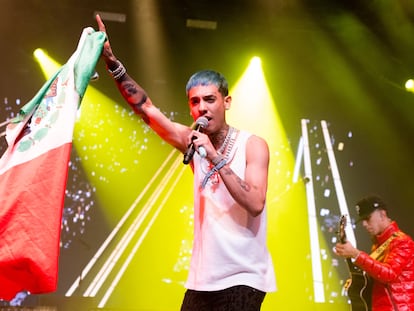The Pachucos: Mexico’s last zoot-suit dandies
Born of the US-Mexico borderland gangsterism of the 1930s, the counterculture has a style that signifies rebellion. Abandoning violence, in Mexico, the movement’s last guardians are keeping the tradition alive through aesthetic ritual and dance-floor flair
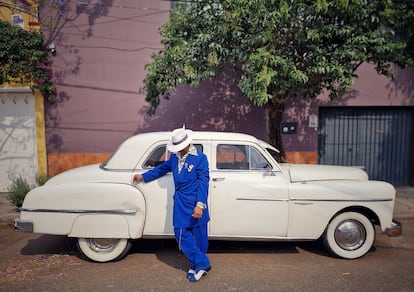
The closet door swings wide, revealing dozens of brightly colored outfits. The shiny tips of two-tone dress shoes peak out from the shelves. On a mirrored dresser sit wide-brimmed hats with feathers, chain watches, suspenders and rhinestone cufflinks. For José de la Rosa, alias Pachuco Nereidas, this dressing room is his own private chapel. Watching him adjust his cufflinks and angle the feather in his hat, scrutinizing himself in the mirror with an expression of serious concentration, is like witnessing the ritual of a bullfighter getting dressed before entering the ring. This is where José curates the transformation that connects him with his truest self. “Los pachucos somos de sangre — we pachucos are bonded by blood,” he says. “My grandfather was a pachuco and my father after him. This is not a costume, it’s a way of life passed down through the generations,” he says. José de la Rosa’s chest reveals a life story told through tattoos and scars. On his sternum, his nom de guerre is engraved in ink, next to a tattoo of an eagle devouring a snake: Mexico’s national coat of arms. His scars are testimonies of more violent and less romantic times, when the pachucos struggled to stay afloat in the murky waters of gang conflict, before becoming the peaceful dandies they are today. “Ready!” he exclaims, tapping his finger on the brim of his hat — the proud gesture of someone who knows he’s the king of the neighborhood. Parked in front of his house: a spectacular white 1950s Dodge with worn brown-leather seats completes the postcard image from a decade 70 years past.
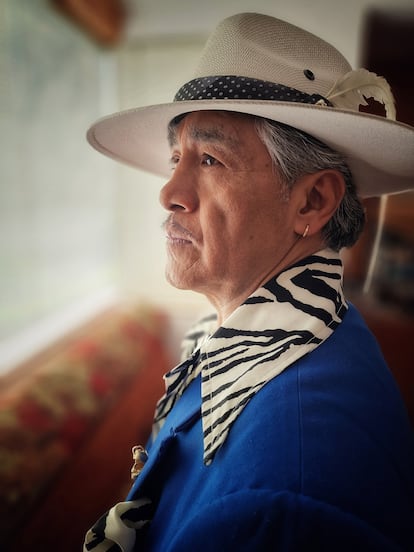
The pachucos were born as a youth gang movement in the late 1930s in the U.S.-Mexico border region. “They were the children of second-generation immigrants who suffered everyday racism. Marginalized, orphans in a no man’s land, they rebelled against an American society that excluded them,” explains Mexican sociologist Vicente Froilán Escamilla, an expert in urban cultural expression. The movement’s members were certainly no fans of Nobel Prize-winning Mexican author Octavio Paz, who defined them, in an essay titled The Pachuco and Other Extremes, as “impassive and sinister clowns” who “through their grotesque dandyism and anarchic behavior do not so much reveal the injustice and incapacity of a society that has failed to assimilate them as they demonstrate their determination to remain different.” And the pachucos were different, without a doubt. They discovered a unique countercultural identity and turned their clothing into a style of rebellion, and used that style to make their existence known, and above all, be seen.
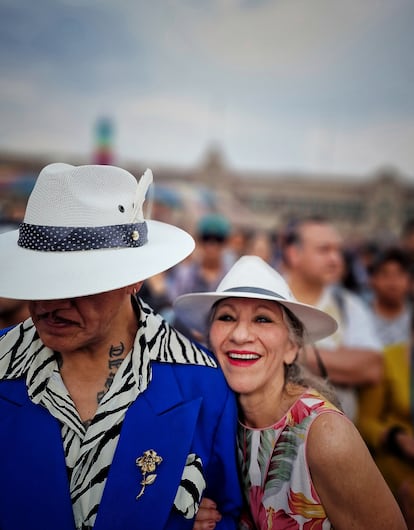
“Aesthetically, the pachucos were inspired by other groups of marginalized migrants, mainly from Harlem, adopting the aesthetic of the zoot suit popular in New York jazz circles and claiming it as their own symbol of rebellion,” says Vicente Froilán. Baggy, high-waisted pants held up by suspenders and cinched at the ankles to highlight their two-tone shoes, with long, bright-colored jackets, exaggerated by shoulder pads, and brimmed hats adorned with feathers.
This exuberant aesthetic had its own soundtrack, with the rhythms of danzón, swing, cha-cha-chá and mambo. And the movement had its own hero on the big screen: Tin-Tan, the character immortalized by Mexican actor Germán Valdés, the star of hundreds of films from the golden age of Mexican cinema who would become the quintessential personification of pachuco culture — the man who left behind his quarrelsome past to assume the friendly party animal lifestyle associated with the movement today. In Mexico City’s Zona Rosa, in the heart of downtown, a four-meter-high statue of Tin-Tan looks ready to jump off its pedestal and onto the dance floor. Music and dance are the glue that holds the pachucos together, compelling these mostly elderly zoot-suiters to leave their homes and gather at Ciudadela Park every Saturday to dance to a live band or a sound system — making an inadvertent and anachronistic tourist attraction — or to wear out their soles on Danzón Tuesdays at the Salón de Baile Los Ángeles. In a way, the pachucos are the last guardians of a style of music that was conceived specifically to be danced to — music that only reveals its true power when experienced on the dance floor. “In Mexico City, there’ll be about 150 of us pachucos. Then there’s the ones in border cities like Chihuahua and Tijuana, and the pachucos who live in Los Angeles,” José tells me.

Today, there’s a musical event taking place in the Zócalo. On our way, we make a brief stop at the storage space where José keeps the rest of his collection. We walk through an auto repair shop, with scrap cars and a mechanic changing tires, and enter a room filled with pachuco memorabilia: hats, shoes and outfits from the eighties carefully stored in clear plastic cases. “I can’t fit them all at home, so I have to store them here,” José says. “Plus, the mechanic who rents me this space also tunes up my old cars, so it’s perfect.” José chooses a fuchsia-pink suit with a matching hat, a white polka dot undershirt and pink and white two-tone shoes. “Now we’re ready for Tuesday,” he says. The Tuesday José is talking about is Martes de Danzón [Danzón Tuesday], an institution within an institution: the official meeting day of the pachucos, held every week at their temple, the Salón de Baile Los Ángeles in Mexico City’s Colonia Guerrero. The place opened its doors in 1937 — it is the oldest dance hall in Mexico — and the music hasn’t stopped playing since. More than just a dance hall, the Salón de Baile is a time capsule. Its walls are covered with hundreds of photographs of bands that passed through and played at the place over the decades. In one corner, there is an altar commemorating Dámaso Pérez Prado, the king of mambo, who popularized the style from this very stage in the 1940s.
“On one of these tables, Benny Moré wrote the lyrics to Bonito y sabroso on a napkin,” says Miguel Nieto, the director of the dance hall. “On this very floor, Frida Kahlo danced with Diego Rivera. The history of Mexico’s culture and music was written in each of these corners,” he adds, gesturing with the pride of someone who owns a space as sacred as a cathedral, but way more fun. “The salon’s motto, coined by my father, is: ‘If you don’t know the Salón Los Ángeles, you don’t know Mexico.’ It’s a phrase that speaks to the salón and the neighborhood, but also to the city of Los Angeles, because if you don’t know that city, you don’t know a very important part of Mexican culture — migrants — and it was precisely those migrants who created the pachuco movement.”

The doors have not even opened and the pachucos are already starting to arrive. The median age is around 60. At 69, Carlos Bueno is one of the older participants, and he looks impeccable in his ivory suit, shimmering gold shirt, pendants, gilded brooch and embroidered hat. “I’ve been coming here for 40 years,” he says. “For me, being a pachuco means being free, doing what you want, and enjoying dancing and life no matter how old you are.” There can be no pachuco without a rumbera (or a jaina, as the women of the movement are called). Carmen, Carlo’s partner in romance and dance, who is sheathed in a silver and green elastic bodysuit with rhinestones and a plume of green feathers, could pass for a circus trapeze artist from a bygone era. “For me, to be able to dress like the 1930s rumberas is something magical. I’ve had a fascination with these outfits since I was a little girl,” she says. “The pachucos and rumberas of Mexico City are like a family. We all know each other, and when one of us is gone, we miss them very much.” Given the age of the pachucos, “is gone” exudes a tragic air, and a reminder that we might, right now, be witnessing the last generation of Mexican dandies, observing the last dance of a species on the verge of extinction.
My somber thoughts are quickly dispelled when Zaira and Joshua walk through the salón doors: a couple of decidedly young pachucos, perfectly matched in their metallic blue suits. “My grandfather was an old-school pachuco. For me it’s a pleasure, a privilege, and it has become part of my life. It’s about continuing to explore and find our identity. We’re not from there, we’re not from here, but we’re here,” Joshua explains, alluding to the uprooting of his ancestors. Zaira adds: “The old rhythms like cha-cha-chá and danzón might be a bit alien to those of us of the younger generation, but when you’re on the dance floor and you get caught up in the music, something truly magical catches you. Dressing up for the occasion, the dancing... everything is a ritual.”
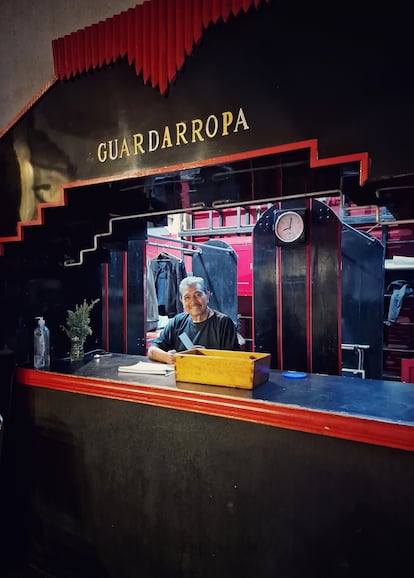
As the band takes the stage, the salón begins to fill with people. In this democratic space, class difference dissolves and people from all walks of life share the experience as equals. At one of the tables next to the dance floor, an elegant man in a tuxedo and black bow tie sips a glass of champagne with his wife, who is dressed in a fine yellow tulle evening gown. Three tables away, a group of women are celebrating a birthday with quesadillas, mole, and homemade cake that they brought in tupperware containers. On the dance floor, pachucos mingle with the hundreds of couples lined up to starts the next danzón. A bit later, a conga sounds and the pachucos take the center of the floor, showing off their choreography and forming part of a chorus of dancers around them who try to imitate the moves of the veteran performers.

Descending the wide spiral staircase, Pachuco Nereidas appears in his brand new pink zoot suit with the air of a vintage gallant who strides through the crowd almost reverentially. A quick shoulder movement, accentuated by the suit’s large shoulder pads, and a combination of frenetic dance steps on the checkered tiles, make clear, in just two moves, the impressive pedigree of this dandy dancer. Throughout the evening, many couples will pass through his arms in cadenced danzones from a bygone era. “Our culture will survive, it will never die,” José says, before inviting a lady to join him for the next danzón. “The pachuco is elegance, the pachuco has dignity. In short, the pachuco lives, and the dance goes on,” he says, disappearing onto the floor, melting into the elegant embrace of the crowd of dancing couples.
Sign up for our weekly newsletter to get more English-language news coverage from EL PAÍS USA Edition
Tu suscripción se está usando en otro dispositivo
¿Quieres añadir otro usuario a tu suscripción?
Si continúas leyendo en este dispositivo, no se podrá leer en el otro.
FlechaTu suscripción se está usando en otro dispositivo y solo puedes acceder a EL PAÍS desde un dispositivo a la vez.
Si quieres compartir tu cuenta, cambia tu suscripción a la modalidad Premium, así podrás añadir otro usuario. Cada uno accederá con su propia cuenta de email, lo que os permitirá personalizar vuestra experiencia en EL PAÍS.
¿Tienes una suscripción de empresa? Accede aquí para contratar más cuentas.
En el caso de no saber quién está usando tu cuenta, te recomendamos cambiar tu contraseña aquí.
Si decides continuar compartiendo tu cuenta, este mensaje se mostrará en tu dispositivo y en el de la otra persona que está usando tu cuenta de forma indefinida, afectando a tu experiencia de lectura. Puedes consultar aquí los términos y condiciones de la suscripción digital.
More information
Archived In
Últimas noticias
Mexico seeks to shore up its defenses following US incursion in Venezuela
Hope gives way to uncertainty among Venezuelan exiles in the US after Maduro’s capture
Cubans look to Venezuela fearfully after Trump’s incursion: ‘We could be next’
The operation in Venezuela to capture Maduro threatens to widen the cracks in the MAGA movement
Most viewed
- Alain Aspect, Nobel laureate in physics: ‘Einstein was so smart that he would have had to recognize quantum entanglement’
- Gilles Lipovetsky: ‘If you want to live better and fall in love, take Prozac, don’t look to philosophy’
- Alvin Hellerstein, a 92-year-old judge appointed by Bill Clinton, to preside over Maduro’s trial in New York
- Cuba confirms death of 32 of its citizens in the US attack against Venezuela
- Why oil has been at the center of Venezuela-US conflicts for decades
